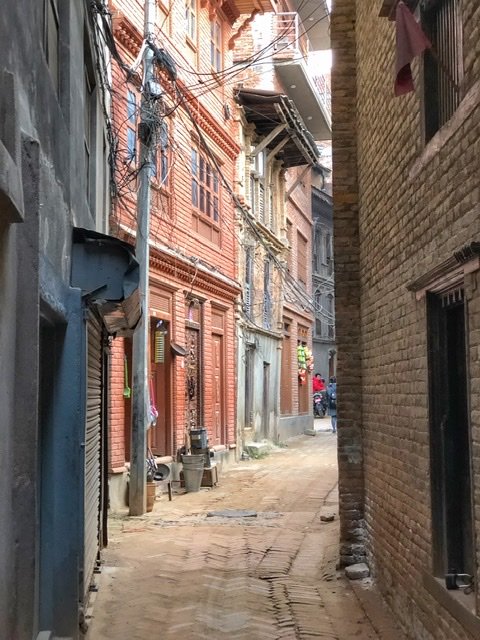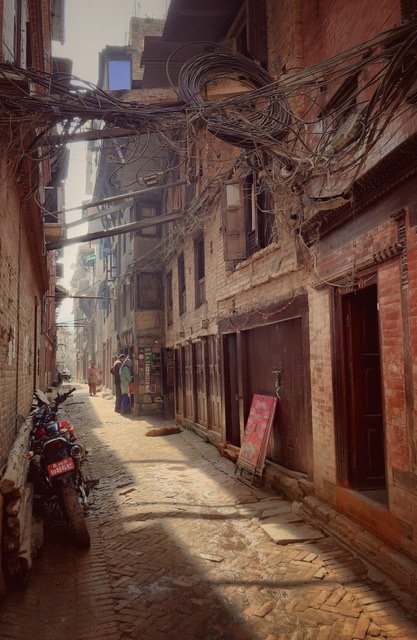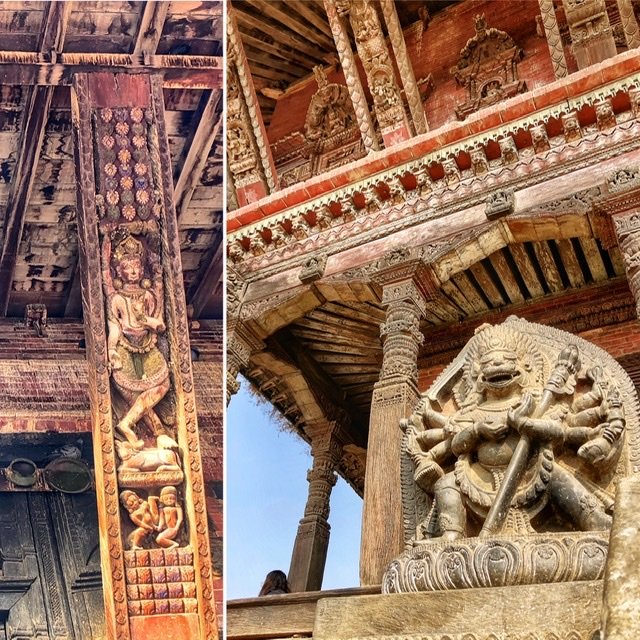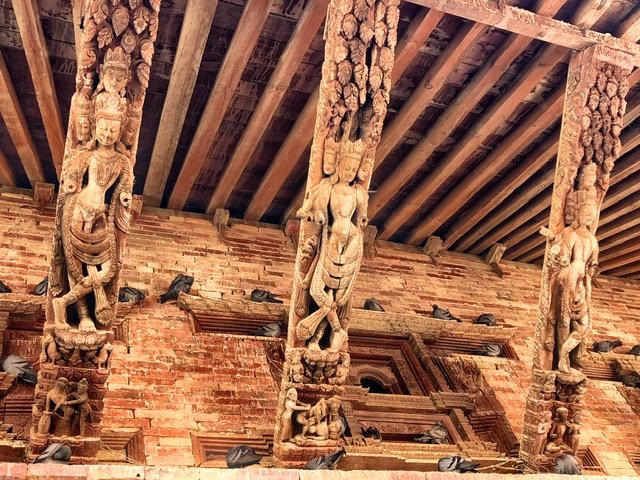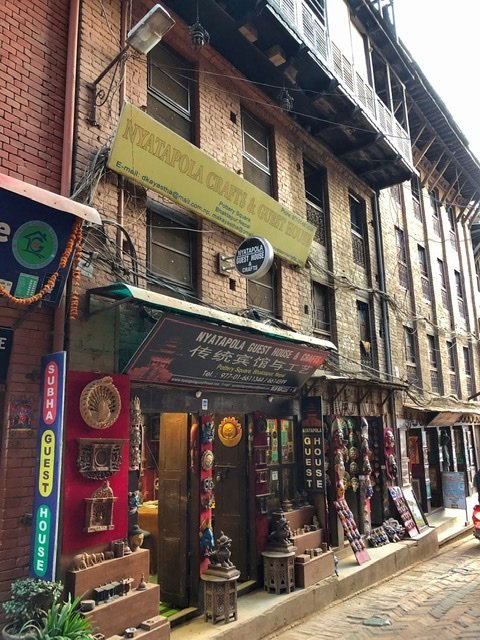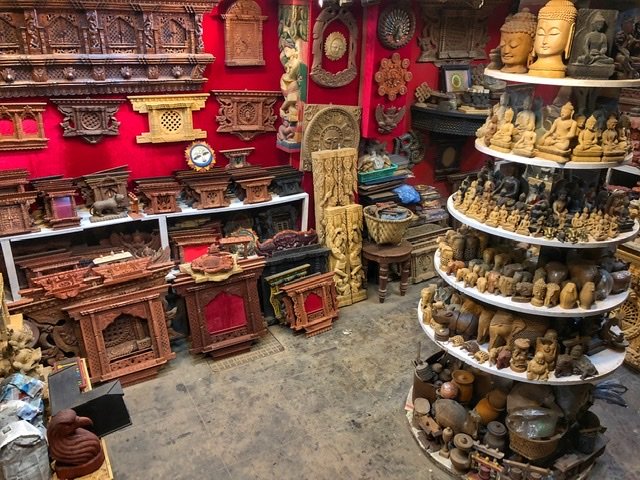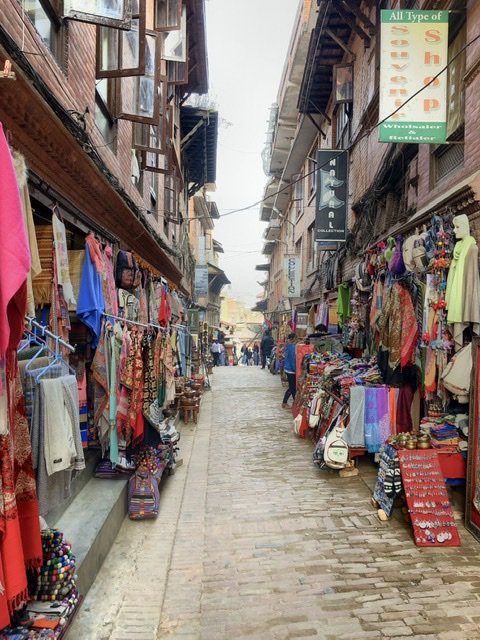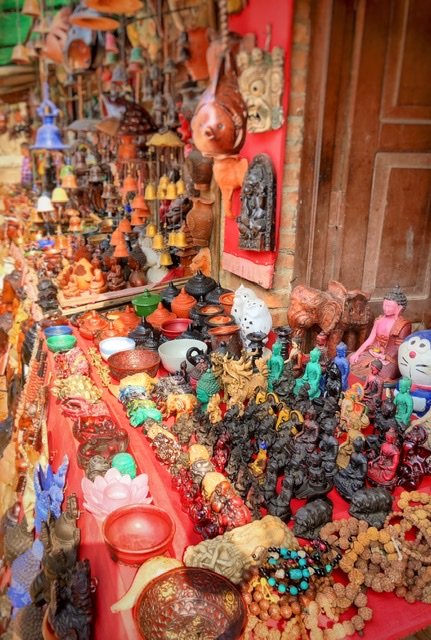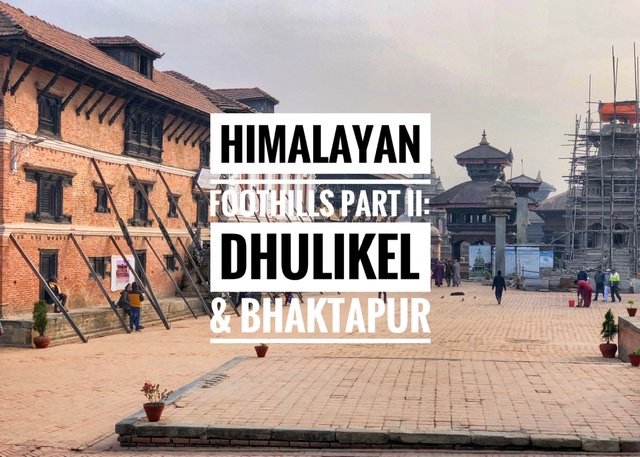
Two hours by local bus ($.50/ticket) east from Kathmandu brought us to the small village of Dhulikel. We sought two things here…fresher air, and views of the eastern Himalayas. Both, it turned out were only marginally attainable at our new address. The locals here (and guidebooks) claim that on clear days you can see the entire Himalayan range, including almighty Everest. We had to wonder though…was those days past us?! It was distressing to realize that We lay at the foot of the most magnificent mountain vistas on earth and it remains forever totally obscured by a thick soup of pollution.
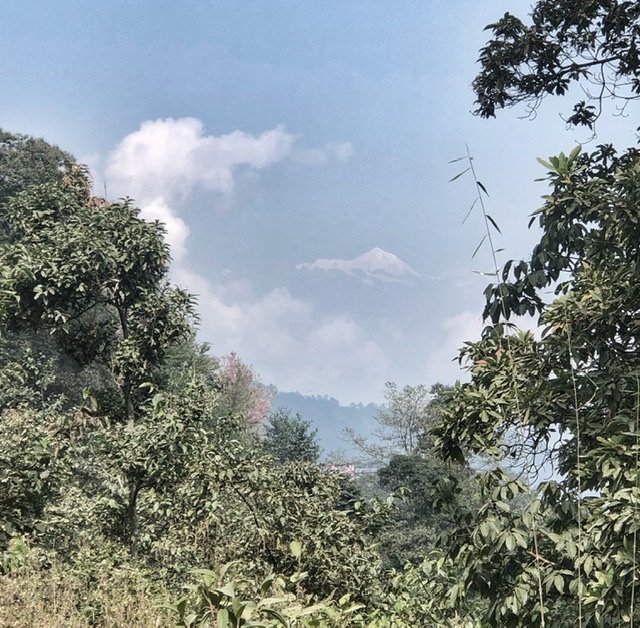
This is why we were elated to while taking a walk to Namo Buddha (a not-so-nearby monastery) when we gazed longingly at the horizon, and… then, suddenly at just above soup level, we realized it was not another cloud, but a peak seemingly floating in the middle of the sky. So surreal.
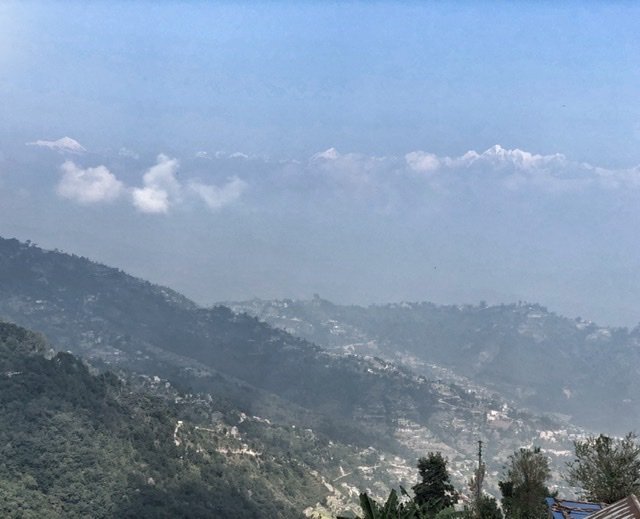
We then realized you could actually see the faint outline of more peaks. That they really were there!
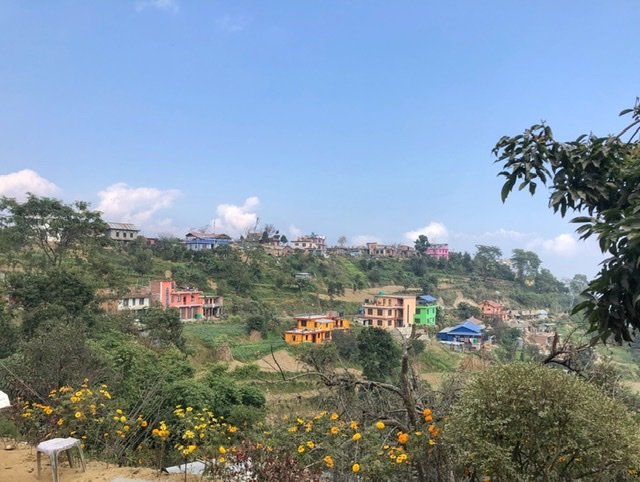
The rolling foothills and Newari villages were actually quite nice.
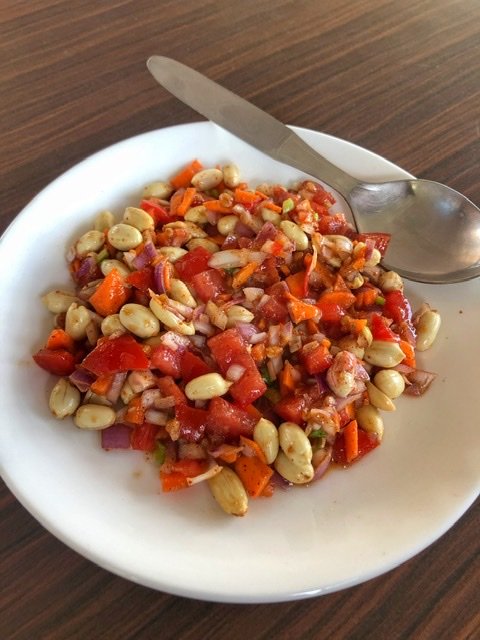
Stopping for a snack, we had Badam Sadheko, which turned into one of our favorite little treats in Nepal. A spicy “salad” made with peanuts, onions, tomatoes, peppers and carrots. Mmmm….
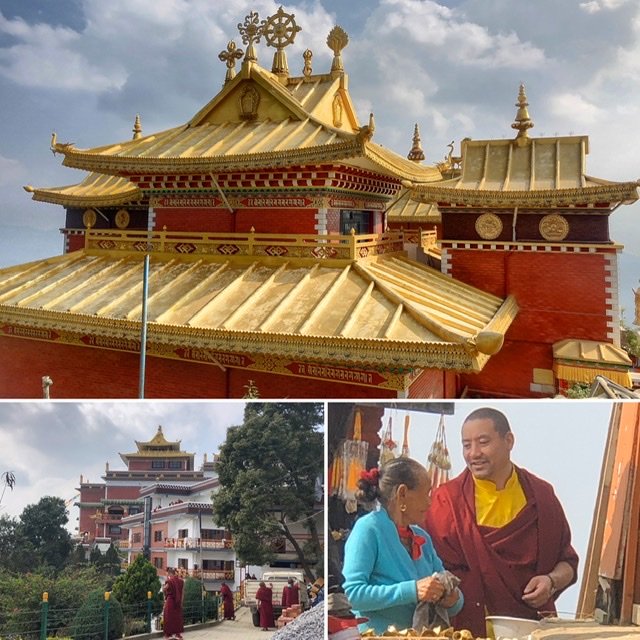
After a not-too short 10 mile walk(!), in which Greg admitted his throat was beginning to feel scratchy, we arrived at our destination, Namo Buddha, an important Buddhist pilgrimage site. The site was interesting, but probably not worth a 20-mile round-trip venture…or accelerating whatever condition was now happening to Greg’s lungs.
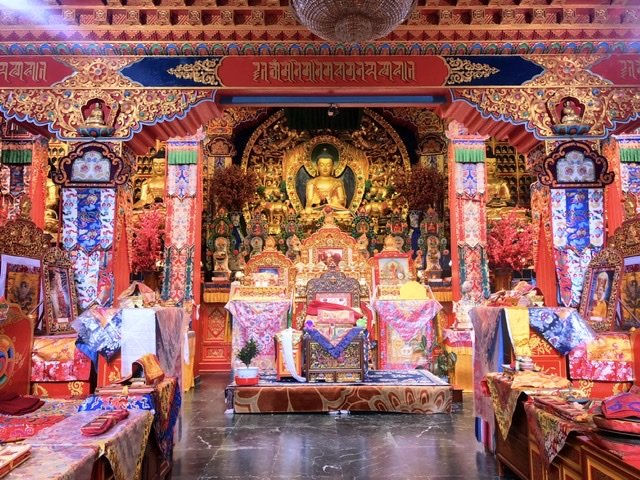
Inside the main monastery. Wow! It was so unbelievably vivid.
One of the best things about travel is coming across cultural ceremonies or rituals that are completely unexpected. This video was at Namo Buddha, a very important Buddhist pilgrimage site which lies about 38 kilometers east of Kathmandu. The stupa and shrines built on this hill mark a very ancient holy site which represents the place where Mahasattva, a notable prince, offered himself to a starving tigress with several underfed cubs.
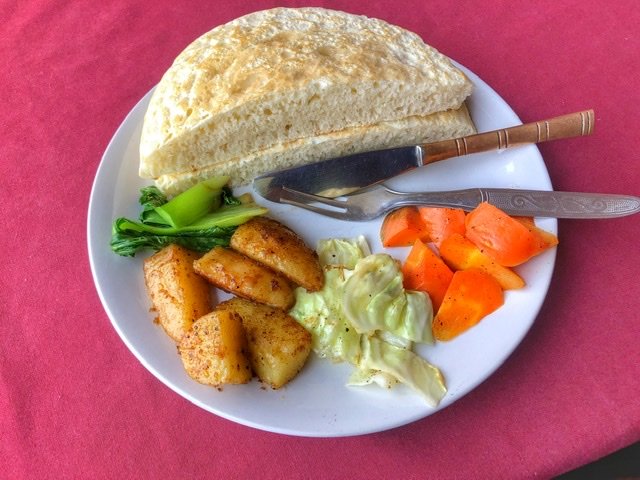
Our place, rather ironically was named Bhattidanda Fresh & Natural Homestay. A family run business operated by the kindest family who certainly tried their best despite the current state of the environment to persevere with a huge on-site organic garden and growing plentiful vegetables. Every morning they generously served us breakfast along with the fattest, fluffiest pancakes we’ve ever had and raw honey.
The story of the family was inspiring. They were Tamang, which is the largest and also the poorest ethic group in Nepal, often entirely uneducated. Most Tamang individuals by fate end up being manual laborers and porters. We learned of the hardships of the mother, Fulmaya, whose own mother left early, and then as an adult, she was cast off from her family after bearing four daughters. Females, historically, are devalued and considered to be “useless” by many in this society. Ironic they are useless considering women are the ones that are expected to lug water for miles, cook the food and make the alcohol (which is typically sold.) Fortunately, through a cooperative she initiated in her village, she was able to turn her life around for her family and not only provide, but open this fruitful homestay. Three of her daughters are studying at university level now, and the fourth helps run the homestay with her husband, who was the only one who spoke a higher level of English.
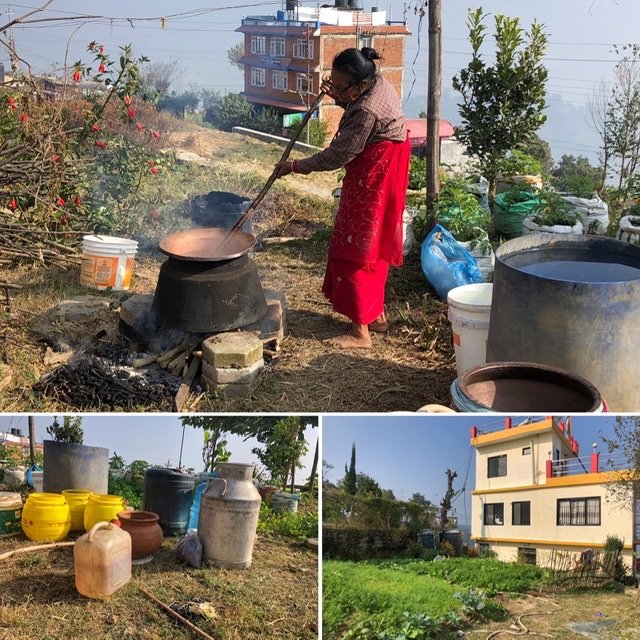
We even got to watch the grandmother make homemade Nepalese beer out of millet as she had done for ages.

Greg models the view for you. ?
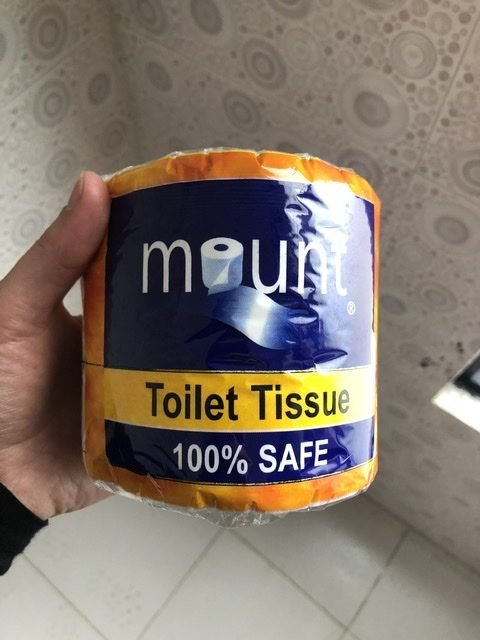
Whew! At least this is safe. Forget about two-ply.
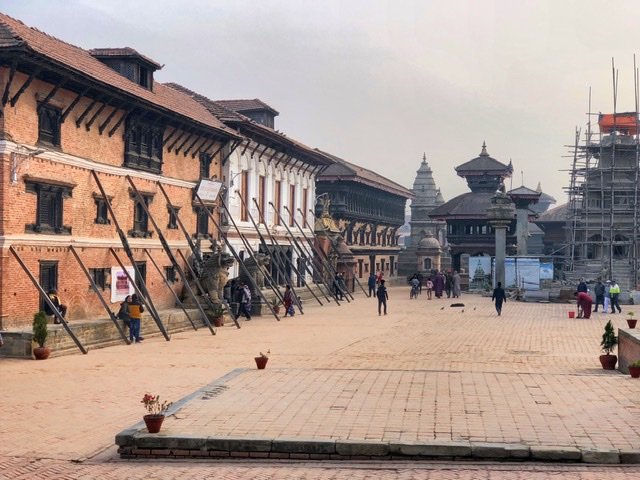
Bhaktapur
After feeling a little gypped by our Nepalese experience in Kathmandu and Dhulikel, we ambled back to Bhaktapur, a medieval UNESCO world heritage town, with pretty low expectations. Those expectations were blown away immediately, even despite the tragic earthquake damage. On the right, the Vatsala Temple was nearly completely destroyed.

Bhaktapur embodies quintessential Nepal at its finest. It is covered in brilliantly crafted architecture, colossal pagoda temples, handicrafts, pedestrian-friendly alleys and streets and a vastly less polluted pocket in which to breathe a little easier, thanks mostly to cars/trucks not being allowed in the entire town. There is also a hefty entrance to access the town of $15/person, much of which goes toward rebuilding efforts. Although this can be an easy day trip from Kathmandu, fortunately, we stayed three nights which made our time here much more worthwhile. Also, we only spent about $15/day on accommodation and food, so we were still happily way below budget.
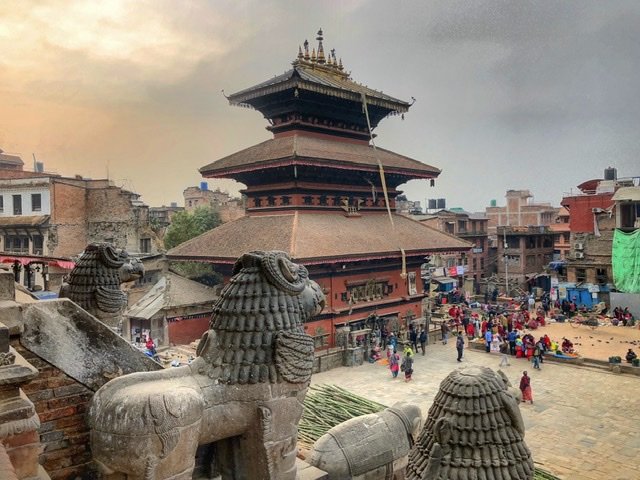
Bhaktapur, dating from the 8th century, is known as the cultural capital of Nepal and it was the actual capital of the country from the 12th to 15th centuries. Its main purpose was to serve as a service town for the trade route between India and Tibet. Its boundary walls form the shape of a flying pigeon. This picture was taken early in the morning at one of three city squares called Taumadhi. You can see how hazy it is, which was the norm.
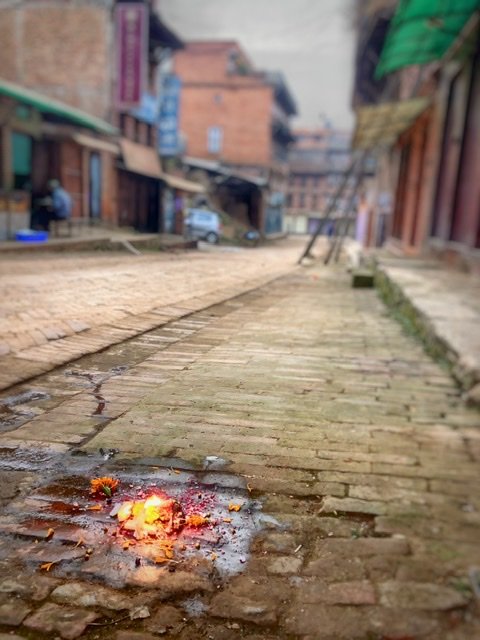
When you walk around in the morning, you will see shrines lit through the town. Curiously, sometimes they light them directly on the pavement.
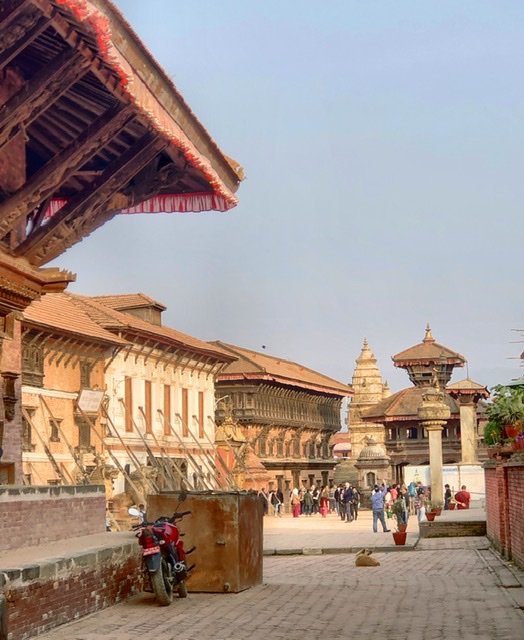
The main square…Durbar was the Royal Palace of the Bhaktapur Kingdom. It is a conglomeration of stone, metal and terra-cotta arts in addition to wood carving to create some real architectural showpieces.
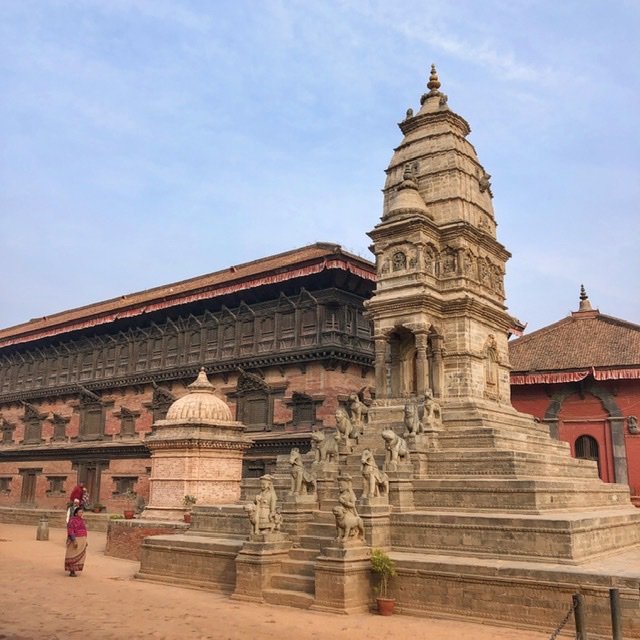
As with many touristy places, we were happy to have the opportunity to explore first thing in the morning sans other tourists. Just us, and the locals. At the opposite end of Durbar Square at the Palace of 55 Windows and the 17th century Stone Siddhilaxmi Temple. If you zoom in, you can see this temple is flanked by an uncharacteristic entourage including a male and female attendant each leading a child and an enthusiastic appearing dog, some rhinos, human-faced lions and camels.
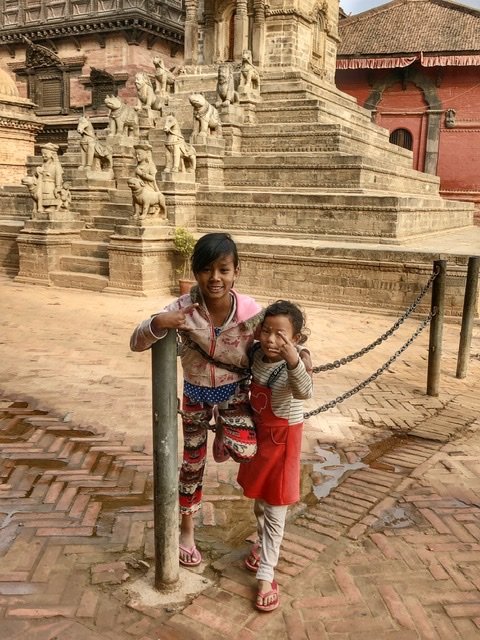
These giddy girls came up to Mandy and asked her to take their picture. Naturally, these little entrepreneurs wanted something in return.

More earthquake damage.
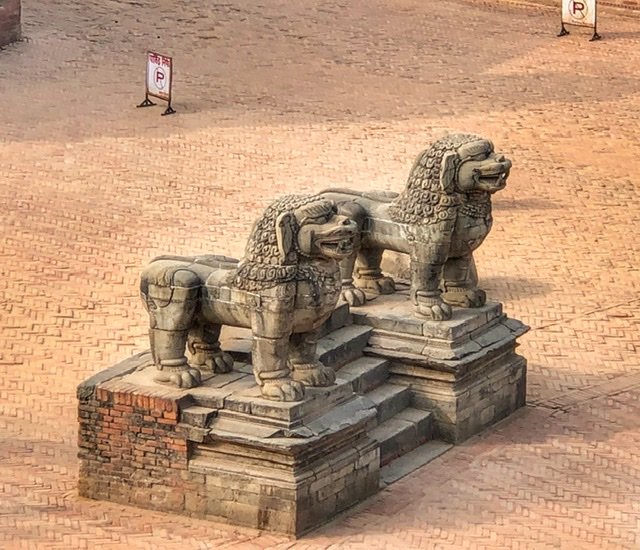
These nearby two lions perch randomly in the middle of an open section near Durbar Square. At one point, before the 1934 earthquake (yes, there’s been many) they guarded something…but amazingly, we read that prior to 1934 there isn’t a lot of photographic documentation as to what was actually there!
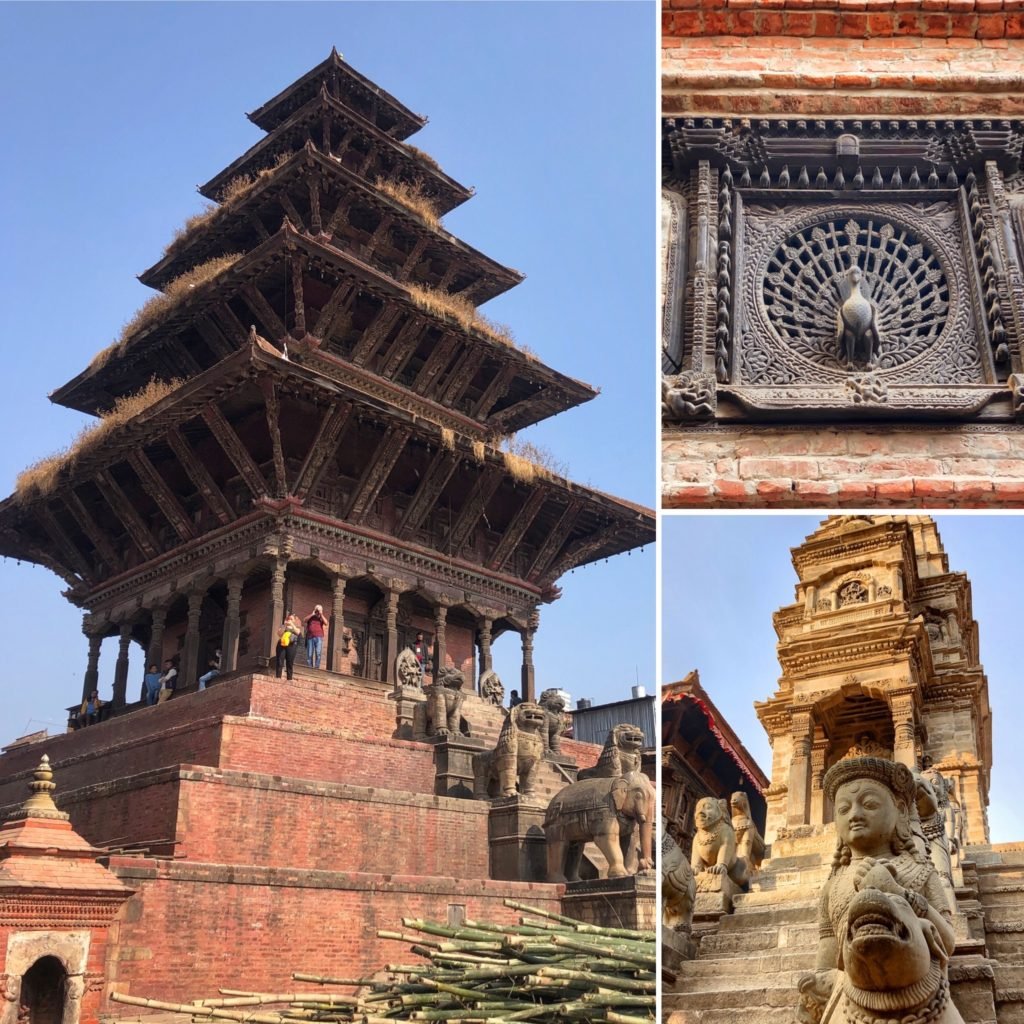
More architectural marvels:
- the Nyatapola Temple, built in 1702 soars five stories above Taumadhi Square and is the tallest temple in all of Nepal. It was so well constructed that it survived with minimal damage in both recent earthquakes
- The Peacock Window is one example of the intricate woodcarving in this town
- Close up shots of the statues leading up to Siddhilaxmi Temple
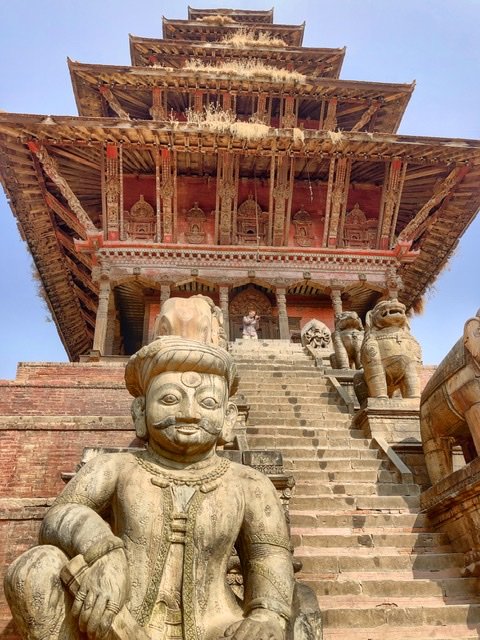
A close-up of Nyatapola Temple.
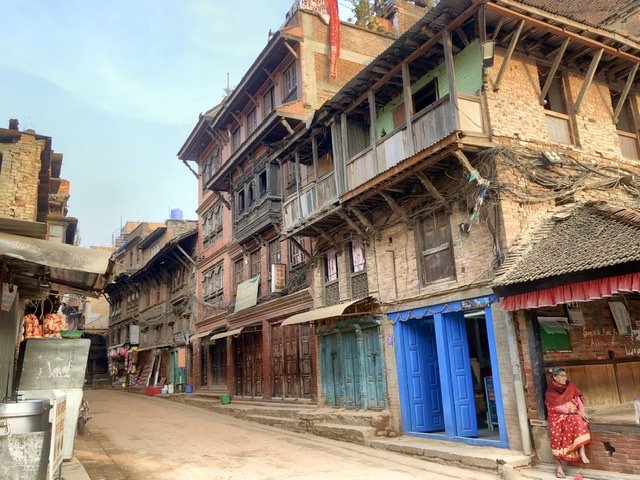
Once you get away from the bustle of the squares, this place is truly a walker’s delight, in which you can easily get lost for hours. Love the lady’s expression in the bottom right corner.
More lovely alleyways almost make you feel like you’re in Europe. (Don’t mind the massive clumps of electrical wires ?)

One of the less idyllic streets.

Pottery is one of the world’s oldest professions. The potters in Bhaktapur spin away on traditional wooden wheels at a crazily speedy pace. This square was completely empty early in the morning, and by afternoon it looked like this!!
The details are truly enamoring. If you zoom into the bottom left corner, certain tantric images might really catch your eye! These images are everywhere! Apparently, according to medium.com, these appearances non-withstanding, such images have nothing to do with worldly sex or eroticism. Rather, they are tangible expressions of a profound metaphysical concept that salvation results from the merging of two primary cosmic aspects, male and female.
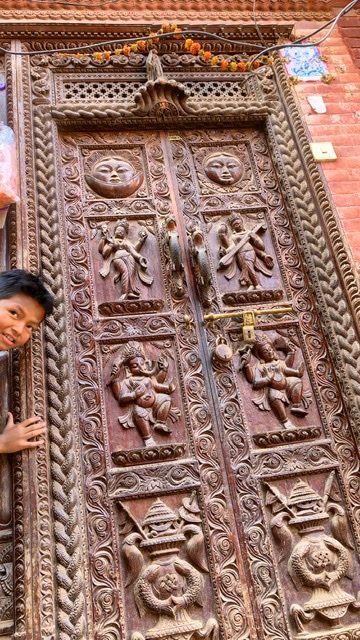
We had a little photo bomber when snapping the details on this door!
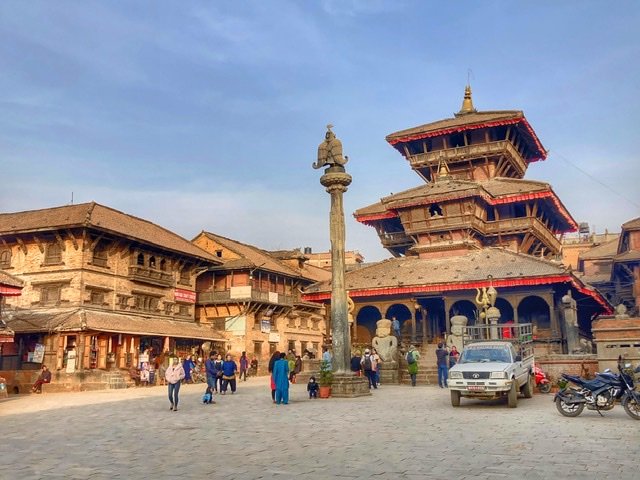
The distinctive Dattatreya Temple was originally built in 1427, supposedly using the timber from a single tree. According to Lonely Planet, it also includes more unexpected images including some comic relief of one bored looking woman washing her hair while being pleasured by her husband (or some other dude.) Unfortunately, we didn’t find the obscurity.
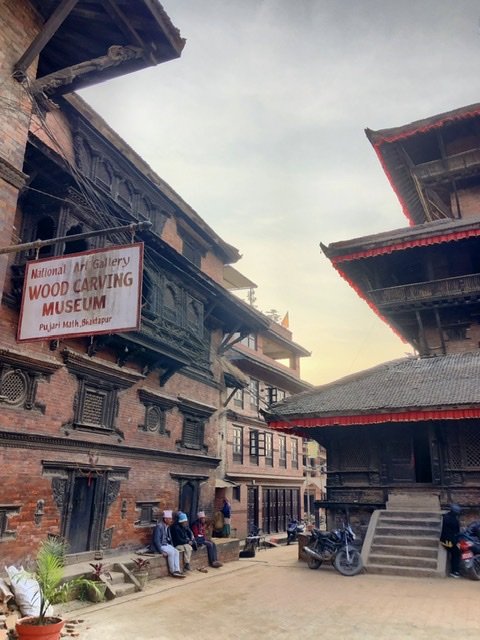
Near the Wood Carving Museum.
Speaking of wood carving, we stayed in the guesthouse of a wood carving family! ($9/night.) Nyatapola Guesthouse had an entire wood shop and even taught wood carving classes. Greg was planning to take one, but unfortunately he was hacking up his lungs in Bhaktapur. Needless to say, sawdust and respiratory problems don’t mix. ?
If you’re not looking for wood carvings, this town is a shopper’s paradise in many other ways. Get your Nepalese latest fashions!
Nepal was undoubtedly the toughest place to avoid buying souvenirs. The selection was unbelievable.
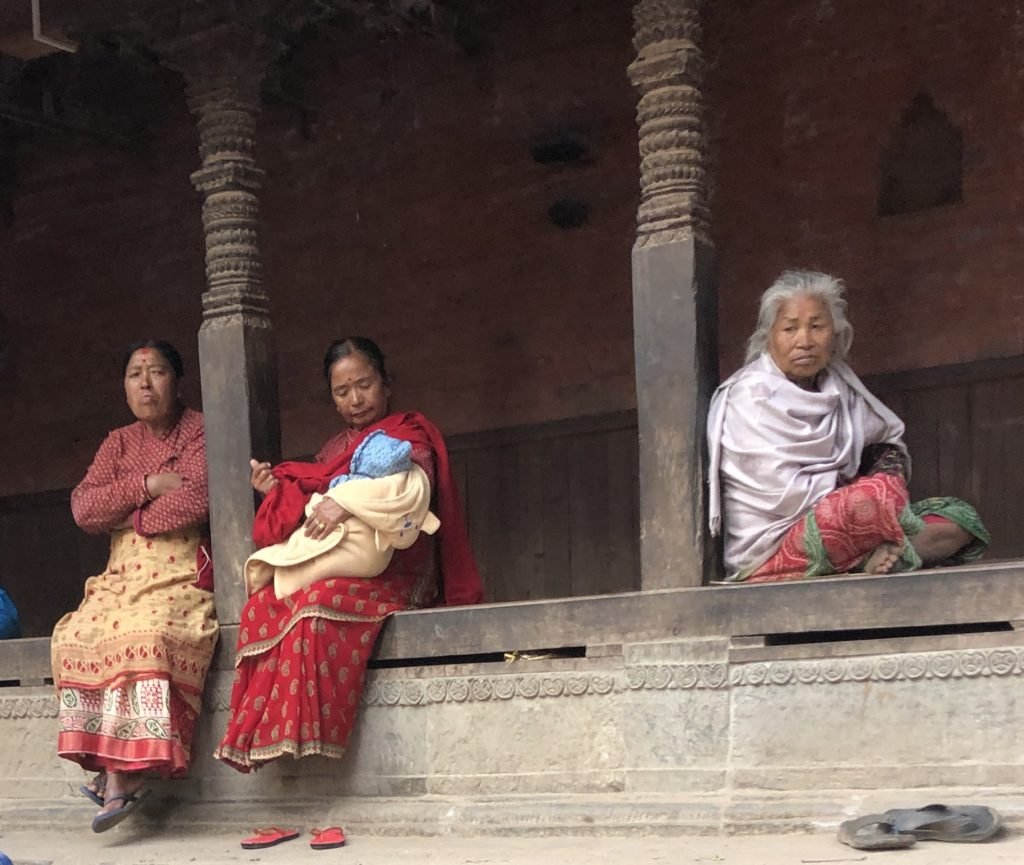
Although Bhaktapur is touristy, we loved the fact that daily life buzzes on as it has for hundreds of years. The juxtaposition of these three women seemed to capture the essence of time.
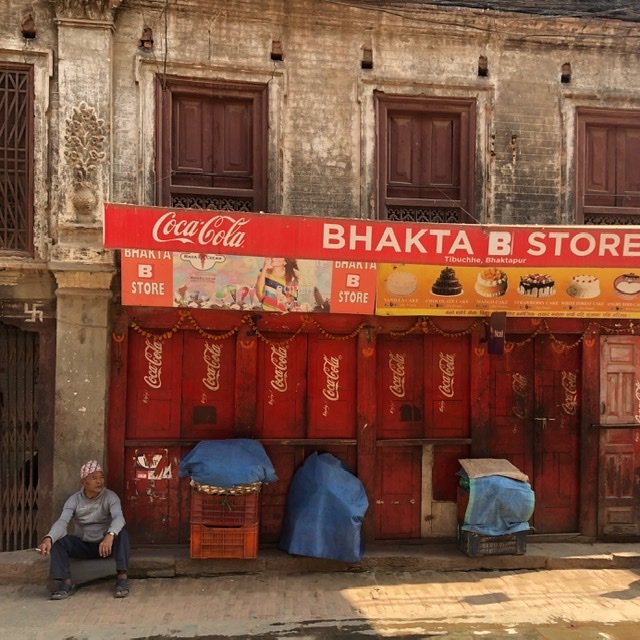
This man takes a break on the side of the road.
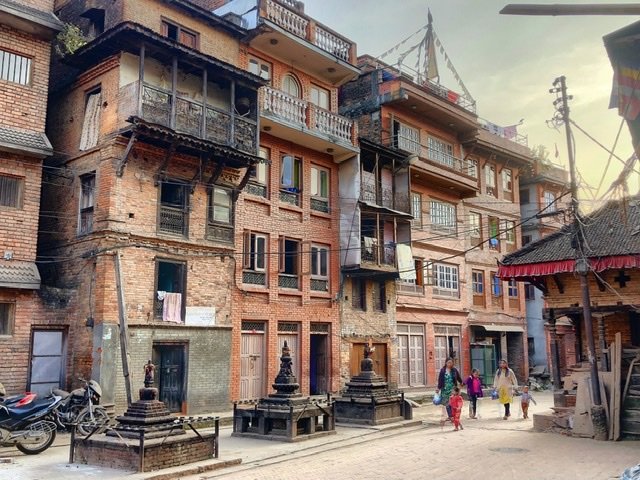
A family walks through a backstreet.
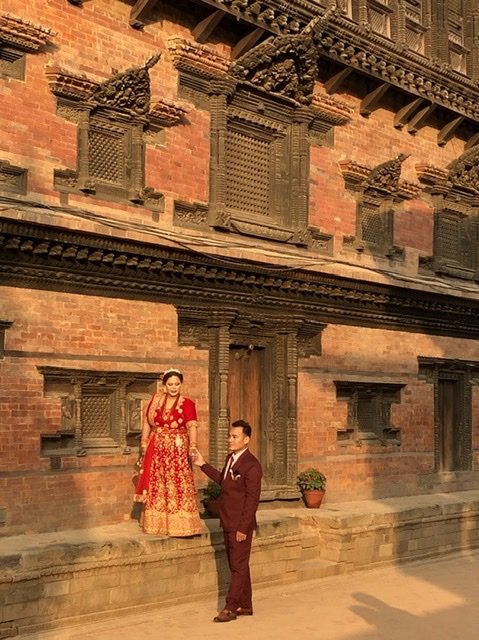
We stumbled across this couple having their wedding photos done at the Palace of 55 windows.

Bhaktapur is known for producing Juju Dhau (King Curd), which is probably the most delectable yogurt we’ve ever had in our life, made from naturally sweet buffalo milk. It is boiled up in an iron pot along with cloves, cardamom, coconut and cashew – sugar, properly, isn’t added at all – and then cooled slowly, with the addition of an older batch to introduce the lactobacillus that makes it curdle. They are served in clay bhingat bowls which are whipped up in a day in nearby pottery square, but unfortunately are not reused.
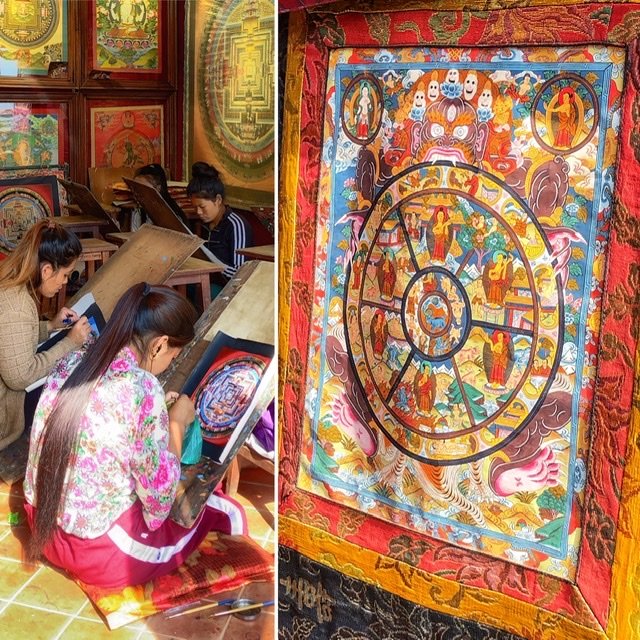
Thanka Painting is a traditional Buddhist cultural tradition. These paintings are not only valued for their aesthetic beauty, but primarily for their use as aids in meditational practices. The level of detail and size of the brushes used is astounding and a painting such as the one pictured can take 4-6 months and cost anywhere from $30-$300, depending on size and quality.
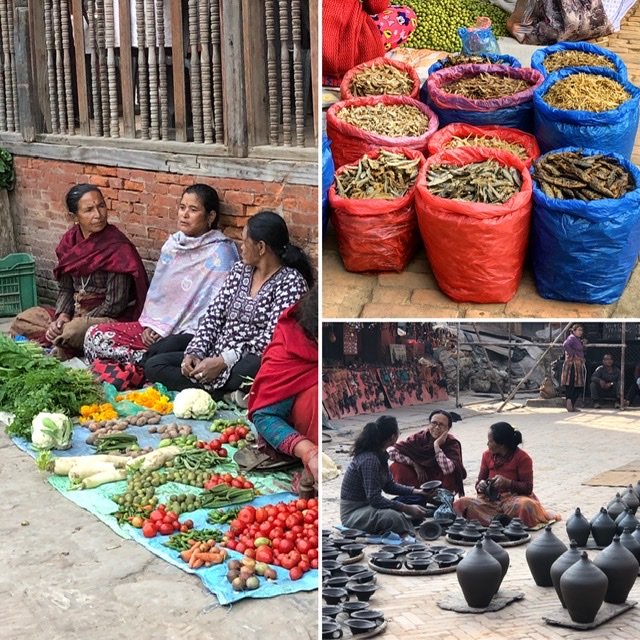
- It was common to see the ladies of the community clustered together selling produce.
- Bags of dried fish for sale. Certainly the only fish even worth considering buying in a developing country so far from the ocean!
- Also in potters square, taking a break from their craft making.
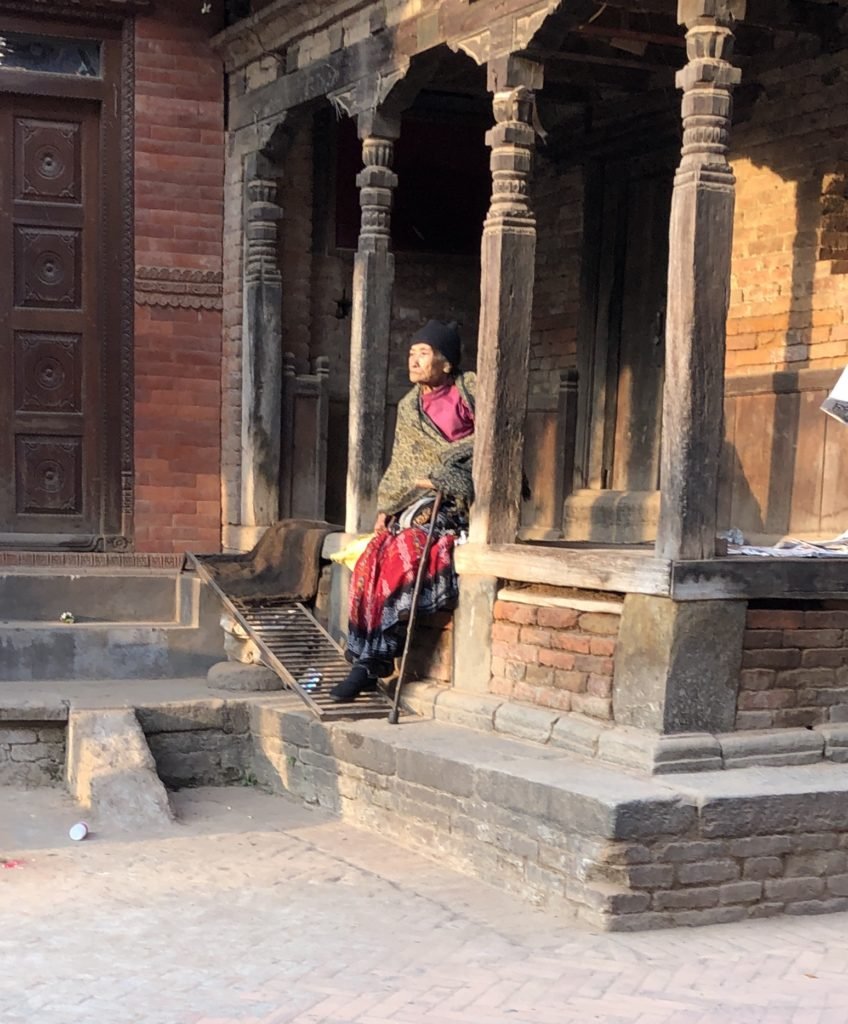
Caught this lovely lady enjoying the fading evening sunlight.
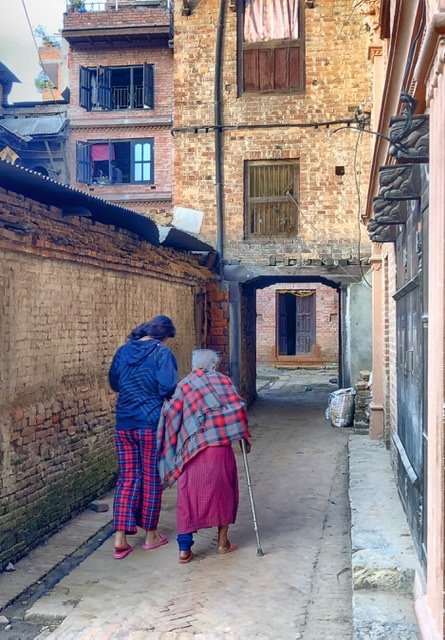
It’s hard not to think about the loss of life this city experienced during the quake or how devastating it must have been on this community. It’s wonderful to see people helping people.

It’s typical to see the streets of Bhaktapur covered in various stages of reconstruction.
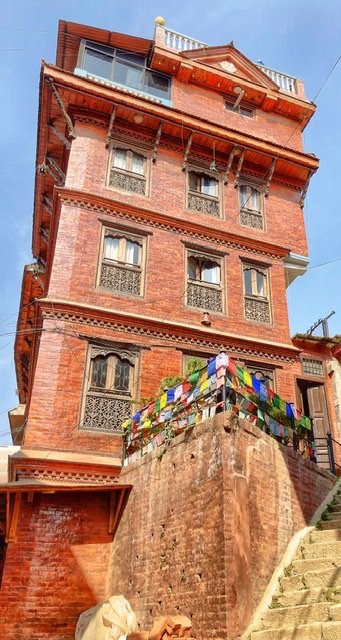
A stunning apartment block. We loved the tall narrow brick buildings. They were often topped with restaurants beholding lovely views of the city.
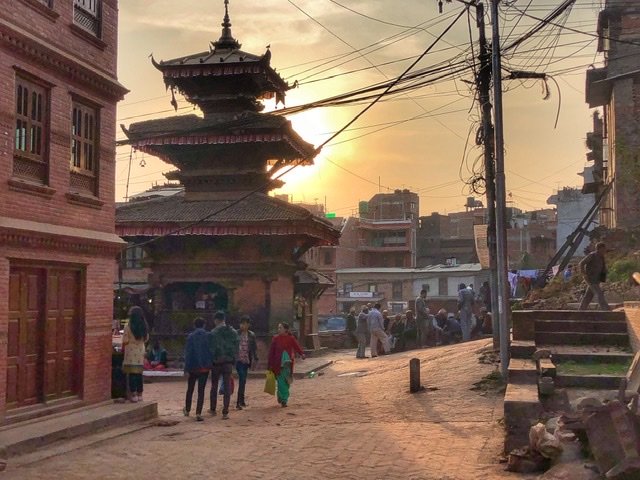
And with that, our time in Nepal came to an end. From tiger trekking in the jungle of Bardia, to hiking the Himalayas, to surviving some of the most wicked bus rides to date, to encountering some of most poverty-stricken, yet richest people we’ve ever crossed paths with. It’s not an easy country, but it’s one that changed us. And we’ll never forget our time here.
Oh, and on our way up and out of Nepal and into India we finally got our Everest! Or at least, that’s what we’re telling ourselves.
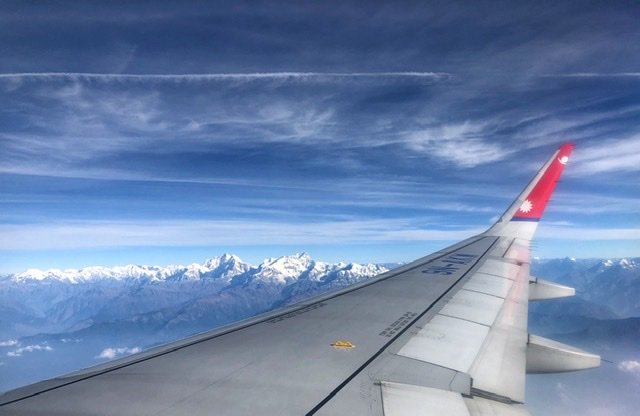
Inevitably, there were more highs and lows… But the ultimate (literal) high was picking our jaws off the floor as we gazed at the nearly parallel most hypnotic mountain range on this planet from our plane window. (Tip…ask for the right side out of Kathmandu!). It was absolutely stunning. Considering we were cruising at around 30,000 feet and the tallest mountains are 26,000+ feet, it’s literally like they had hijacked on the wing and were riding along with Us. They go on endlessly. The Himalayas are truly remarkable.
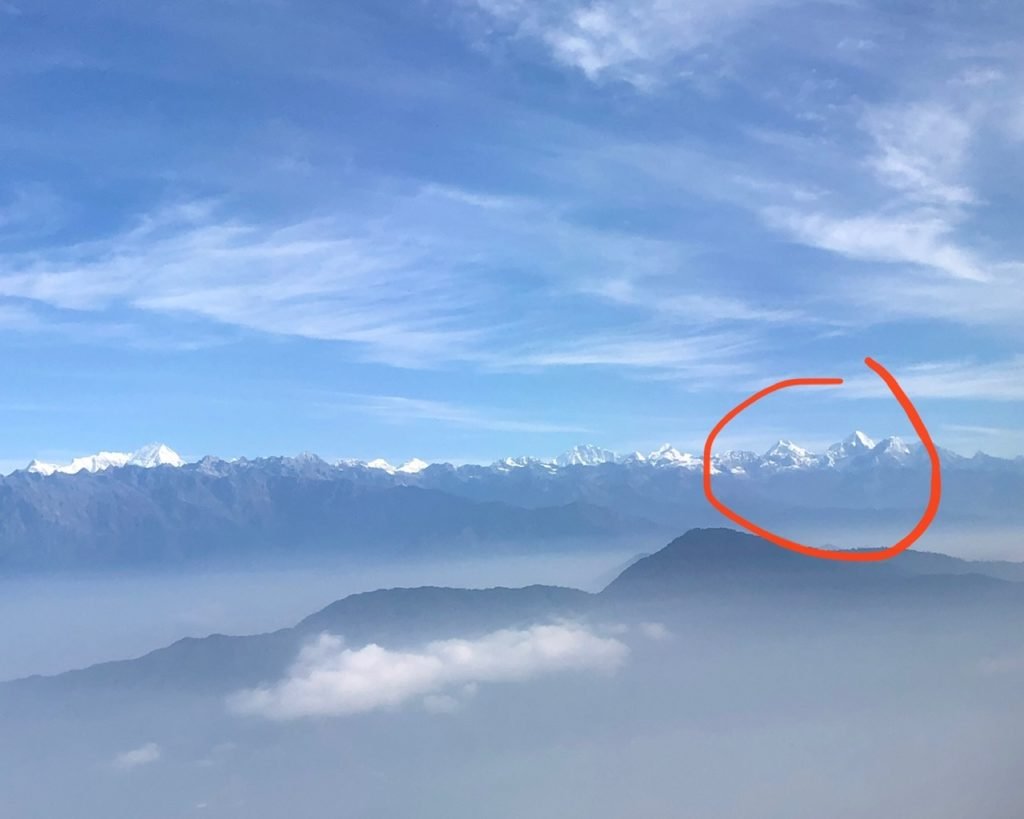
Nepal Wrap-Up
Time Spent: 27 days
Money Spent: $1109.58 ($41.09/Day)
Budget Travel Meter*: $
The upsides of Nepal
- Trekking in the most magnificent mountain range on earth
- Nepal is very, very cheap and very budget friendly…perhaps the most inexpensive country we have ever visited. $30/day for a couple, is easily achievable. Higher cost items in our budget for Nepal included our visas ($50/person) and our jungle trek excursion ($90)
- The unique introduction to Buddhism
- Although many people live in poverty, the Nepalese were rich with kindness and heart to travellers like us
- Dhal Bhat. This everyday traditional meal, consisting of curried lentils, stewed greens, rice, and potatoes served across Nepal is nourishing, cheap, and yummy.
- The cultural immersion of Newari villages of the Kathmandu Valley
- Bargaining. While it can take some getting used to, bargaining is a way of life in Nepal, and jumping in can quickly net you some incredibly lucrative deals in an already cheap country
- English, while wildly fluctuating in fluency, is at least widely understood.
The downsides of Nepal
- Busses. Unless you can nab a “Deluxe” tourist grade bus for a day time journey, the local busses are, at best, difficult. Taking the local busses will certainly take a toll on your well being in Nepal. They are also incredibly dangerous, Nepal has one of the worst casualty rates in the world for bus usage (avoid the night busses at all costs if you value your life!)
- The high cost of the visa ($50/each) for American tourists
- The pollution. Air, water, noise, and land pollution is severe and quite harmful to your health in the Kathmandu Valley and Teraj regions. While in the Kathmandu Valley the air quality levels were rated “Very Poor/Harmful” every day for the week we were there and are the 3rd worst in the world. Add to this, heavy metals have recently been found in the municipal drinking water supplies in the Kathmandu Valley, and arsenic in the Teraj region. Getting a face mask and bottled water are therefore mandatory purchases. 🙁
- Anti-pedestrian (aside from the Himalayas.) In Nepal, the lowly walker is on the bottom of the right-of-way totem pole.
- Food variety. Aside from a few traditional standouts like Dhal Bhat, Nepal is not a foodie destination.
- Quality, or specific medicines are difficult to get
Would we go back? Unlikely.
Budget Travel Meter* The Budget Meter gauges how hard it was for us to stick to our $50/day budget factored by our daily food consumption options.
- $ – Eating-out up to twice a day and ordering whatever the hell we want, with dessert!
- $$—Eating-out once a day in a restaurant of our choice
- $$$—Eating-out once a day, on cheap pizza or local street food meals, usually involving copious amounts of filling bread
- $$$$—Eating-in every meal, healthy/fresh & in-season produce options
- $$$$$—Eating powdered soup & potatoes for every meal.
What we wish we knew before we came to Nepal... * The drinking water in the Kathmandu Valley is contaminated with heavy metals and arsenic in Nepalgung (Teraj region); bottled water is a must. * In Nepal, you bargain for everything, accommodations, supplies, bus tickets, restaurant meals, etc. * Make sure to negotiate (bargain) the price of your bus fare before you enter the bus. * DO NOT travel in Nepal during Diwali festivities. * The Nepalese don’t shake hands... the standard greeting is “Namaste” with the palms together, fingers pointed upwards. * Don’t buy your onward bus tickets from your accommodations. We got burned twice by doing this. Buy your tickets instead from a reputable travel agency, or directly from the bus conductor/driver.

